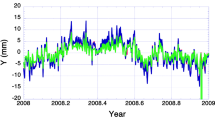Summary
Precise orbits of the Global Positioning System (GPS) satellites are fundamental constituents of GPS-based space geodesy. Accurate baseline estimates with a precision of one to a few parts in 108 are essential to the study of Earth's dynamics problems. As a by-product of trajectory estimation, high resolution Earth Rotation Parameters (ERPs) can also be determined. A new application of triple differencing for efficient evaluation of GPS orbits in a PC environment is presented here. Initial tests show that this approach is capable of providing orbits that are highly compatible with the results obtained by the International GPS Service for Geodynamics (IGS). This approach allows for completely automated data processing without the overhead of working with very large normal matrices or cycle-slip fixing.
Similar content being viewed by others
References
Eren, K. (1986) GPS Geodetic Network Adjustment Using Triple Difference Observations and a Priori Information,manuscripta geodaetica, Vol. 11, pp. 289–292.
Goad, C.C., Remondi, B. (1984) Initial Relative Positioning Results Using the Global Positioning System,Bulletin Geodesique, Vol. 58, pp. 193–210.
Goad, C.C., Mueller, A. (1988) An Automated Procedure for Generating an Optimum Set of Independent Double Differences Observables Using Global Positioning System Carrier Phase Measurement,manuscripta geodaetica, Vol. 13, pp. 365–369.
Kouba, J. (1995) IGS Analysis Coordinator Report, 1995.
Remondi, W., B. (1989) Extending the National Geodetic Survey Standard GPS Orbit Formats, NOAA Technical Report NOS 133 NGS 46.
Rothacher, M., Beutler, E., Brockmann, E., Gurtner, W., Mervart, L., Weber, R., Wild, U., Wiget, A., Seeger, H., Boucher, C. (1994) Annual Report of the CODE Analysis Center for 1993, IERS Technical Note 17, pp. P-1 – P-14.
Schaffrin, B. and Grafarend, E.W. (1986) Generating classes of equivalent linear models by nuisance parameter elimination. Applications to GPS observations,manuscripta geodaetica, Vol. 11, No. 4, pp. 262–271.
Seeber, G. (1993)Satellite Geodesy, deGruyter.
Springer, T.A., Beutler, G. (1993) Towards an Official IGS Orbit by Combining the Results of All IGS Processing Centers, Proceedings of the 1993 IGS Workshop, pp. 242–249.
Author information
Authors and Affiliations
Rights and permissions
About this article
Cite this article
Goad, C.C., Grejner-Brzezinska, D.A. & Yang, M. Determination of high-precision GPS orbits using triple differencing technique. Journal of Geodesy 70, 655–662 (1996). https://doi.org/10.1007/BF00867144
Received:
Accepted:
Issue Date:
DOI: https://doi.org/10.1007/BF00867144




